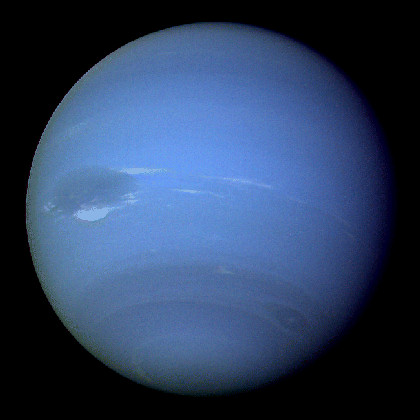
|
Press Release 11/2010
|
 |

|
Press Release 11/2010
|
 |
Press Release 11/2010 - July 16, 2010
A comet may have hit the planet Neptune about two centuries ago. This is indicated by the distribution of carbon monoxide in the atmosphere of the gas giant that researchers - among them scientists from the French observatory LESIA in Paris, from the Max Planck Institute for Solar System Research (MPS) in Katlenburg-Lindau (Germany) and from the Max Planck Institute for Extraterrestrial Physics in Garching (Germany) - have now studied. The scientists analyzed data taken by the research satellite ![]() Herschel, that has been orbiting the Sun in a distance of approximately 1.5 million kilometers since May 2009. (Astronomy & Astrophysics, published online on July 16th, 2010)
Herschel, that has been orbiting the Sun in a distance of approximately 1.5 million kilometers since May 2009. (Astronomy & Astrophysics, published online on July 16th, 2010)
When the comet Shoemaker-Levy 9 hit Jupiter sixteen years ago, scientists all over the world were prepared: instruments on board the space probes Voyager 2, Galileo and Ulysses documented every detail of this rare incident. Today, this data helps scientists detect cometary impacts that happened many, many years ago. The "dusty snowballs" leave traces in the atmosphere of the gas giants: water, carbon dioxide, carbon monoxide, hydrocyanic acid, and carbon sulfide. These molecules can be detected in the radiation the planet radiates into space.
In February 2010 scientists from MPS discovered strong evidence for a cometary impact on Saturn about 230 years ago (see Astronomy and Astrophysics, Volume 510, February 2010). Now new measurements performed by the instrument PACS (Photodetector Array Camera and Spectrometer) on board the Herschel space observatory indicate that Neptune experienced a similar event. For the first time, PACS allows researchers to analyze the long-wave infrared radiation of Neptune.

|
|
Figure 1: Two centuries ago a comet may have hit Neptune, the outer-most planet in our solar system. |
|
(Credits: NASA) |
The atmosphere of the outer-most planet of our solar system mainly consists of hydrogen and helium with traces of water, carbon dioxide and carbon monoxide. Now, the scientists detected an unusual distribution of carbon monoxide: In the upper layer of the atmosphere, the so-called stratosphere, they found a higher concentration than in the layer beneath, the troposphere. "The higher concentration of carbon monoxide in the stratosphere can only be explained by an external origin", says MPS-scientist Paul Hartogh, principle investigator of the Herschel science program "Water and related chemistry in the solar system". "Normally, the concentrations of carbon monoxide in troposphere and stratosphere should be the same or decrease with increasing height", he adds.
The only explanation for these results is a cometary impact. Such a collision forces the comet to fall apart while the carbon monoxide trapped in the comet’s ice is released and over the years distributed throughout the stratosphere. "From the distribution of carbon monoxide we can therefore derive the approximate time, when the impact took place", explains Thibault Cavalié from MPS. The earlier assumption that a comet hit Neptune two hundred years ago could thus be confirmed. A different theory according to which a constant flux of tiny dust particles from space introduces carbon monoxide into Neptune’s atmosphere, however, does not agree with the measurements.
In Neptune’s stratosphere the scientists also found a higher concentration of methane than expected. On Neptune, methane plays the same role as water vapor on Earth: the temperature of the so-called tropopause - a barrier of colder air separating troposphere and stratosphere - determines, how much water vapor can rise into the stratosphere. If this barrier is a little bit warmer, more gas can pass through. But while on Earth the temperature of the tropopause never falls beneath minus 80 degrees Celsius, on Neptune the tropopause's mean temperature is minus 219 degrees.
Therefore, a gap in the barrier of the tropopause seems to be responsible for the elevated concentration of methane on Neptune. With minus 213 degrees Celsius, at Neptune’s southern Pole this air layer is six degrees warmer than everywhere else allowing gas to pass more easily from troposphere to stratosphere. The methane, which scientists believe originates from the planet itself, can therefore spread throughout the stratosphere.
The instrument PACS was developed at the Max Planck Institute for Extraterrestrial Physics. It analyzes the long-wave infrared radiation, also known as heat radiation, that the cold bodies in space such as Neptune emit. In addition, the research satellite Herschel carries the largest telescope ever to have been operated in space.
E. Lellouch et al.
First results of Herschel /PACS observations of Neptune
Astronomy & Astrophysics, Vol. 518, L152 (2010), DOI: 10.1051/0004-6361/201014600
on July 16th, 2010 available under
![]() http://www.aanda.org/articles/aa/abs/2010/10/contents/contents.html
http://www.aanda.org/articles/aa/abs/2010/10/contents/contents.html
T. Cavalié et. al.
A cometary origin for CO in the stratosphere of Saturn?
Astronomy & Astrophysics, Vol. 510, February 2010, DOI: 10.1051/0004-6361/200912909
Dr. Birgit Krummheuer
Press and Public Relations
Max Planck Institute for Solar System Research
Max-Planck-Straße 2
37191 Katlenburg-Lindau
Tel.: +49 5556 979 462
Fax: +49 5556 979 240
Mobil: 0173 3958625
Email: krummheuer![]() mps.mpg.de
mps.mpg.de
Dr. Paul Hartogh
Max Planck Institute for Solar System Research
Max-Planck-Straße 2
37191 Katlenburg-Lindau
Tel: +49 5556 979 342
Email: hartogh![]() mps.mpg.de
mps.mpg.de
| © 2009, Max Planck Institute for Solar System Research, Lindau |
Presseinfo 16-07-2010 |